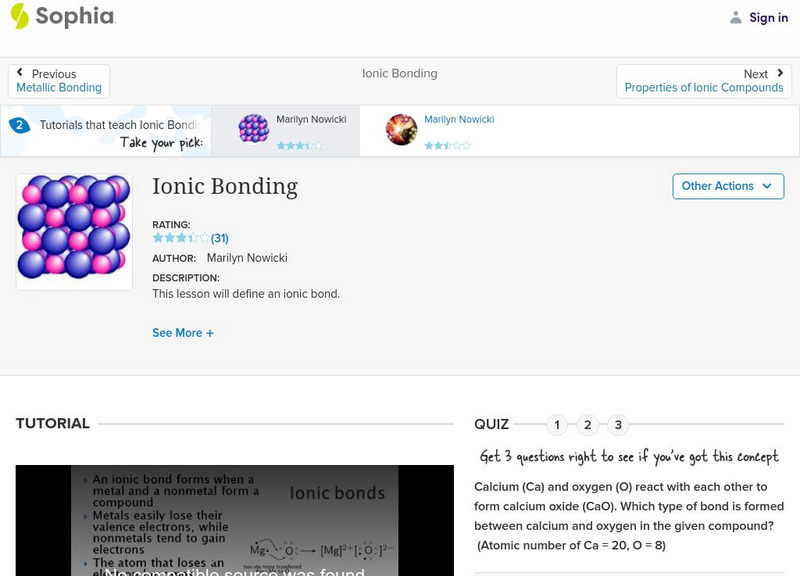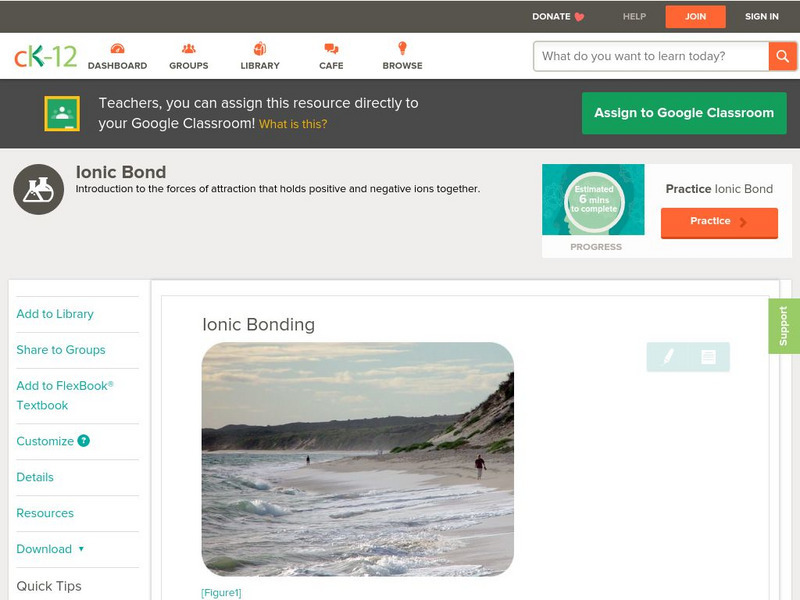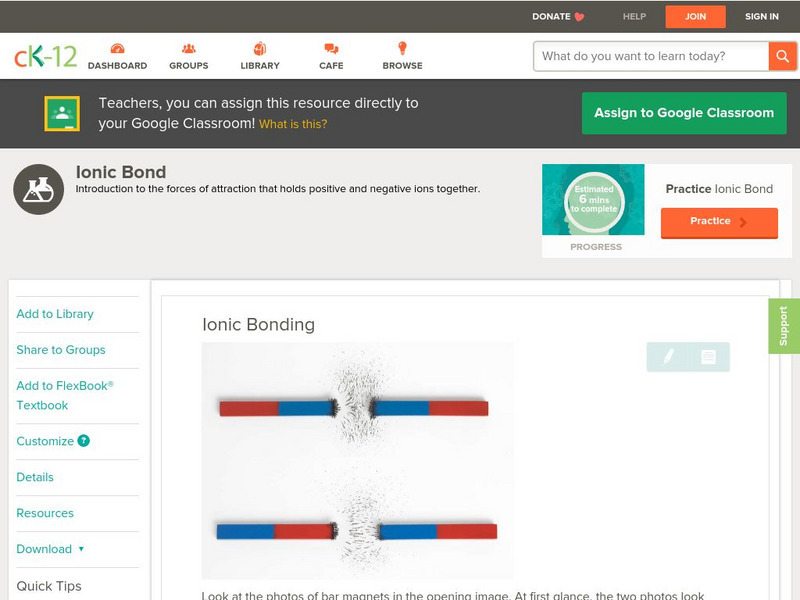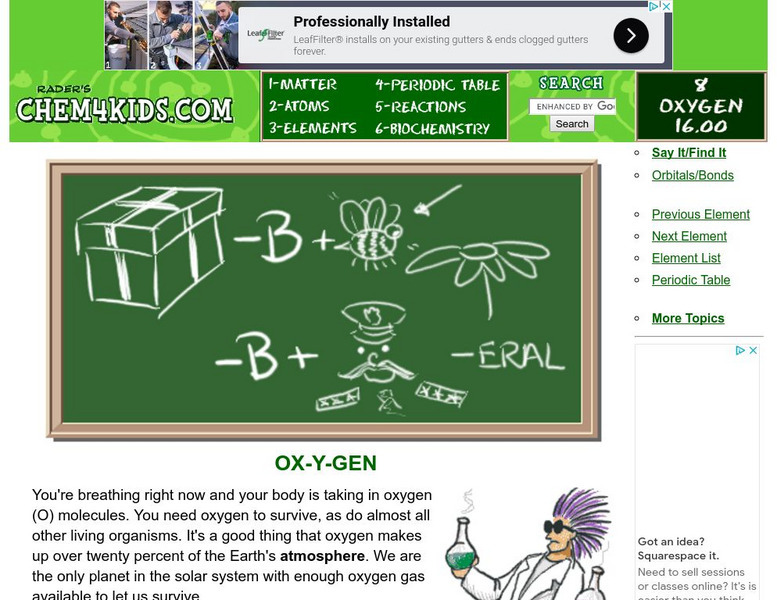Chem4kids
Chem4 Kids: Sulfur (S)
Here you can find some great information about the 16th element in the periodic table, "sulfur." Content focuses on sulfur's electrons, where you can find sulfur in nature and in the home, and how sulfur combines with other elements.
Chem4kids
Chem4 Kids: Chlorine (Cl)
The 17th element in the periodic table is defined, chlorine. Find out how many electrons chlorine has and where you can find it in nature and in the home.
Chem4kids
Chem4 Kids: Argon (Ar)
Chem4Kids looks at the 18th element in the periodic table, argon. Content focuses on argon's electrons, where you can find argon in nature and in the home, and how argon combines with other elements.
PBS
Pbs Teachers: Why the Towers Fell: The Structure of Metal
Examine what it is that gives metal its special characteristics and how metal behaves under the stress of heat and outside forces. An engaging interactive feature is offered to here to illustrate this concept.
Concord Consortium
Concord Consortium: Stem Resources: Chemical Bonds
By working through this web-based activity, students differentiate between ionic, non-polar covalent, and polar covalent bonds. Specifically, distinctions are made between bonding types based on orbital shapes and electronegativity...
American Chemical Society
Middle School Chemistry: Represent Bonding With Lewis Dot Diagrams
Students draw and interpret Lewis dot diagrams for individual atoms and both covalent and ionic compounds.
PBS
Pbs Learning Media: Ionic Bonding
In this interactive activity from ChemThink, students will learn how ionic bonds are formed and how an ionic bond structure is represented by its formula.
PBS
Pbs Learning Media: Chemical Bonds
This interactive activity developed for Teachers' Domain demonstrates how attractive forces between atoms create chemical bonds, resulting in the formation of molecules and compounds.
PBS
Pbs Learning Media: Ionic Bonding
A tutorial illustrating ionic bonding. Tutorial explains how and why it occurs with animations and some interactive activities throughout. Explore the bond that forms between sodium and chlorine as you count the number of atoms present.
University of Southern California
Atomic Bonds
This slide show on atomic bonds contains several slides on electron affinity. Other topics include covalent, Sigma and Pi bonds, and atomic bonding in solids.
Ohio State University
Ohio State University: Electronegativity & Bond Polarity
Excellent graphics help this page explain the relationship between electronegativity and bond polarity.
Michael Blaber, PhD
Florida State University: Basic Concepts of Chemical Bonding: Ionic Bonding
This tutorial explains the basic concepts of ionic bonding, with a good discussion of lattice energy.
Quia
Quia: Reading Detective: Main Idea
A 20 question quiz testing knowledge of ionic and covalent bonding.
Other
Chem Cases: Nutra Sweet: Physical and Chemical Properties
An in-depth look at the physical and chemical properties of aspartame, or NutraSweet.
Sophia Learning
Sophia: Ionic Bonding: Lesson 2
This lesson will define an ionic bond. It is 2 of 3 in the series titled "Ionic Bonding."
CK-12 Foundation
Ck 12: Earth Science: Chemical Bonding
[Free Registration/Login may be required to access all resource tools.] Examine the types of chemical bonding.
CK-12 Foundation
Ck 12: Plix Series: Resonance: Metallic Bonding
[Free Registration/Login Required] Manipulate the electrons and protons to explore metallic bonding. Then answer a self-correcting concept question.
CK-12 Foundation
Ck 12: Chemistry: Ionic Bonding
[Free Registration/Login may be required to access all resource tools.] Covers how ions interact with one another in ionic bonds.
CK-12 Foundation
Ck 12: Physical Science: Ionic Bonding
[Free Registration/Login may be required to access all resource tools.] Ionic bonds: How and why they form, and the role of energy in their formation.
CK-12 Foundation
Ck 12: Physical Science: Chemical Bond
[Free Registration/Login may be required to access all resource tools.] Definition of a chemical bond, why they form and the different types.
Chem4kids
Chem4 Kids: Lithium
Here at Chem4Kids you can find some great information about the third element in the periodic table, lithium. Content focuses on lithium's electrons, where you can find lithium in nature, and how it bonds with other elements (or with...
Chem4kids
Chem4 Kids: Oxygen (O)
Here you can find some great information about the 8th element in the periodic table, "oxygen." Content focuses on oxygen's electrons, where you can find oxygen in nature and in the home, and how oxygen combines with other elements.
CK-12 Foundation
Ck 12: Chemistry: Chemical Bond
[Free Registration/Login may be required to access all resource tools.] Definition of a chemical bond, why they form and the different types.
Sophia Learning
Sophia: Chemistry: Electronegativity
Created to teach students of the 21st century, SOPHIA is bringing electronegativity straight to your fingertips. Become the commander of your own learning experiences as you take part in this interactive lesson and help make learning...




















